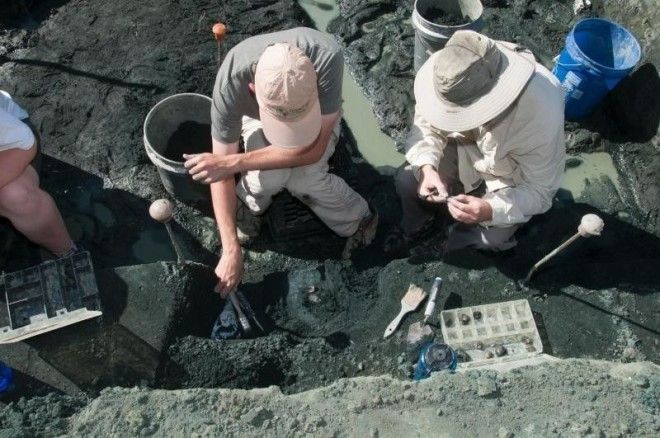While the researchers involved do not have conclusive evidence, and are cautious about making any grand claims, the site at least dates to very close to the famous mass extinction event that ended the reign of the dinosaurs. “We don’t know yet [if it dates from the mass extinction],” says paleontologist Dr. Kenneth Lacovara, who has been the driving force in the excavations of the quarry, “but we are testing this hypothesis by examining the fossils, the sediments and the chemistry.” They are able to date it to close to the impact, as the mass extinction is marked by a thin layer of iridium-rich sediment, an element common in asteroids and comets.

Researchers excavating part of the bone bed that contains thousands of fossils from close to the mass dinosaur extinction.
The quarry pit in Mantua Township in central New Jersey has been owned by the Inversand Company for nearly a century and was mined for marl, a mudstone used as both a fertilizer and for water treatment. But it was also known for its rich fossil deposits, mainly from marine organisms. At the end of the Cretaceous, when the dinosaurs met their maker, the region was a shallow tropical sea full of fish, sea turtles, crocodiles, and even mosasaurs. But at some point around 66 million years ago, whether it was due to the asteroid impact or some other cause, many of the inhabitants of the sea died and were preserved in a large bone bed.
Now the quarry is owned by Rowan University, who bought it off Inversand for $2 million (£1.3 million) towards the end of last year. The university plans to continue with the excavations and to decipher the precise date and cause of the extensive bone bed found at the site. If they can confirm that, then it will be the first mass bone bed dating from the Cretaceous mass extinction, making it an internationally important fossil site that provides a window of insight into what exactly happened back then.
In the meantime, the university also plans on turning the quarry into an education center, with its own museum and facilities to educate and inspire the next generation to get involved in not just palaeontology, but science in general. Perhaps one day they’ll have a world-renowned fossil bone bed with which to learn.

